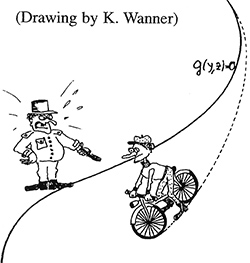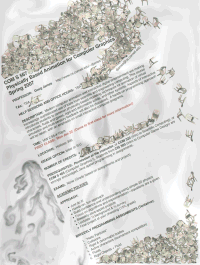- David Baraff and Andrew Witkin, Physically Based Modeling, Online SIGGRAPH 2001 Course Notes, 2001.
- An interesting historical perspective:
- Terzopoulos, D., Pltt, J., Barr, A., Zeltzer, D.,
Witkin,
A., and Blinn, J. 1989. Physically based
modeling: past, present, and future. In ACM SIGGRAPH 89
Panel Proceedings (Boston, Massachusetts, United States, July 31
-
August 04, 1989). SIGGRAPH '89. ACM Press, New York, NY, 191-209.

Discussed differentiating the following quantities with respect to particle position vectors, p_i:
- constant, c
- position, p_j
- vectors, (p_j-p_k)
- distances, ||p_j-p_k||
- distance powers, ||p_j-p_k||^n
- dot products, (p_1-p_0)^T (p_3-p_2)
- cross products
- Example: hair bending energy derivative, E =
k*sin^2(theta/2) [handout]

- David Baraff and Andrew Witkin, Physically Based Modeling, Online SIGGRAPH 2001 Course Notes, 2001.
- Videos:
- Particle Dreams by Karl Sims, 1988.
- Other classic videos:
- Evolved Virtual Creatures by Karl Sims, 1994.
- Panspermia by Karl Sims, 1990.
- Pipe Dream, 2001.

- Forward Euler
- Backward Euler
- Symplectic
Euler (a.k.a. semi-implicit Euler)
- Midpoint
method
- Verlet method (a.k.a. Störmer's method)
- Velocity
Verlet
method
Particle Systems

Assignment #1 Homepage
- Video highlights:
![GPU-accelerated SPH [Harada et al. 2007]](images/thumb_HaradaGPUSPH.jpg)
- Particle interaction force models
- Gavin Miller, Andrew Pearce, Globular dynamics: A connected particle system for animating viscous fluids, Computers & Graphics, 13(3), 1989, pp. 305-309. (Note there are some obvious equation typos)
- Smoothed Particle Hydrodynamics (SPH)
- Matthias Müller, David Charypar, Markus Gross, Particle-based fluid simulation for interactive applications, 2003 ACM SIGGRAPH / Eurographics Symposium on Computer Animation (SCA 2003), August 2003, pp. 154-159. [Video]
- Wikipedia
- Takahiro Harada, Seiichi Koshizuka, Yoichiro Kawaguchi, Smoothed Particle Hydrodynamics on GPUs, Computer Graphics International, pp. 63-70, 2007.
- B. Solenthaler, R. Pajarola, Predictive-Corrective Incompressible SPH, ACM Transactions on Graphics, 28(3), July 2009, pp. 40:1-40:6.
- Granular materials:
- Nathan Bell, Yizhou Yu, and Peter J. Mucha, Particle-Based Simulation of Granular Materials, ACM SIGGRAPH/ Eurographics Symposium on Computer Animation 2005, [PDF] [Video]
- Particle advection
- Isosurface extraction
- Rendering
IMEX and other schemes
![Cloth from [Baraff & Witkin 1998]](images/thumb_BW98.jpg)
- Blackboard
- David Baraff and Andrew Witkin, Physically Based Modeling, Online SIGGRAPH 2001 Course Notes, 2001.
- Implicit Methods (Baraff)
- David Baraff, Andrew P. Witkin, Large
Steps
in
Cloth
Simulation, Proceedings
of
SIGGRAPH
98, Computer Graphics Proceedings, Annual Conference Series,
July
1998, pp. 43-54.
- Implicit-Explicit (IMEX) integration schemes:
- Ascher, Ruuth, Wetton, Implicit-Explicit Methods for Time-Dependent Partial Differential Equations, SIAM J. Num. Anal. 32, pp. 797-823, 1995.
- Bernhard Eberhardt, Olaf Etzmuß, Michael Hauth, Implicit-Explicit Schemes for Fast Animation with Particle Systems, Computer Animation and Simulation 2000, Proceedings of the EG Workshop in Interlaken, 21-22 August, 2000.
- Example: "Going implicit on damping"
Feb17
Corotational Finite Elements

- Blackboard
- Basic continuum mechanics
- Deformation (material and deformed coordinates, deformation gradient)
- Polar decomposition (rotation, stretch)
- Strain (Green, linearized Cauchy)
- Strain Energy
- Stress and forces
- Tetrahedral finite elements
- Corotational finite elements
- References:
- Bonet and Wood, "Nonlinear continuum mechanics for finite element mechanics," Cambridge University Press, 1997.
- M. Müller, M. Gross, Interactive Virtual Materials,
in Proceedings of Graphics Interface (GI 2004), pp 239-246, London,
Ontario, Canada, May 17-19, 2004. [Video]
- J. Georgii and R. Westermann, Corotated Finite Elements Made Fast and Stable, VRIPHYS Workshop in Virtual Reality Interactions and Physical Simulations, 2008. [PDF] [Video]
Feb24
Mar01
![Cloth from [Bridson et al. 2002]](images/thumb_bridson02.jpg)
- Velocity-level collision resolution
- Continuous collision detection
- 2D (point-edge, sphere-sphere), and 3D (point-face, edge-edge) tests
- Impulse resolution
- Supporting pin/trajectory constraints
- Inverse-mass-matrix filtering
- Penalty forces
- Rigid cloth zones
- Cloth related:
- Robert Bridson, Ronald P. Fedkiw, John Anderson, Robust Treatment of Collisions, Contact, and Friction for Cloth Animation, ACM Transactions on Graphics, 21(3), July 2002, pp. 594-603.
- Robust Treatment of Simultaneous Collisions, David Harmon, Etienne Vouga, Rasmus Tamstorf, Eitan Grinspun, ACM Transactions on Graphics, 27(3), August 2008, pp. 23:1-23:4. (equality-constraint alternative to rigid cloth zones)
- X. Provot, Collision and self-collision handling in cloth model dedicated to design garment. Graphics Interface, 177–89, 1997. (first introduction of rigid cloth zones)
- General collision detection:
- M. Lin and S. Gottschalk, Collision detection between geometric models: A survey, Proc. of IMA Conference on Mathematics of Surfaces, volume 1, pp. 602-608, 1998.
- P. Jimenez, F. Thomas, and C. Torras, 3D collision detection: A survey, Computers & Graphics, Elsevier, 25(2), pp. 269-285, 2001.
- Gino Van Den
Bergen, Efficient collision detection
of complex deformable models using AABB trees, Journal of
Graphics Tools, 1998
Robust Collision Processing
(a.k.a. "The Spaghetti Factory")

Assignment #2 Homepage

- Holonomic constraints, C(p)=0.
- Example: Bead on a wire
- Differentiating constraints w.r.t. time.
- Constraint Jacobian, J
- Lagrange multipliers, lambda, and constraint forces, J^T
lambda
- Solving for Lagrange multipliers
- Implicit constraint (and half-explicit) DAE integration
schemes
- David Baraff and Andrew Witkin, Physically Based Modeling, Online SIGGRAPH 2001 Course Notes, 2001.
- Examples from Cloth Simulation:
- Rony Goldenthal, David Harmon, Raanan Fattal, Michel Bercovier, Eitan Grinspun, Efficient Simulation of Inextensible Cloth, ACM Transactions on Graphics, 26(3), July 2007, pp. 49:1-49:7. [ACM Digital Library link]
- Jonathan
M.
Kaldor, Doug L. James, Steve Marschner, Simulating Knitted Cloth at the Yarn Level,
ACM Transactions on
Graphics, 27(3), August 2008, pp. 65:1-65:9.
Mar15

- Poisson's equation model problem
- Overview of space/time complexity results for Poisson's equation
- Iterative methods for sparse linear systems
- Matrix splitting & iterative solution
- Basic Methods:
- Jacobi
- Gauss-Seidel
- Successive overrelaxation (SOR)
- Krylov Subspace Methods
- Basic idea
- Conjugate Gradient Method
- Preconditioning
- Reference:
- James W. Demmel, Applied Numerical Linear Algebra,
SIAM
Press,
Philadelphia,
1997.
(errata)
- Barrett et al., Templates for the Solution of Linear Systems: Building Blocks for Iterative Methods, 2nd edition, 1994.
Mar17
![Rigid bodies in contact [Baraff notes]](images/thumb_rigidbody.png)
- Rigid body concepts (position, orientation, linear/angular
velocity, momentum, inertia, etc.)
- Contact impulses
- Example: rigid zones for cloth
- Frictionless contacts:
- Nonpenetration constraints
- Velocity-level constraints (see Baraff course notes for
accleration-level constraints)
- Linear Complementarity Problem (LCP)
- David Baraff and Andrew Witkin, Physically Based Modeling, Online SIGGRAPH 2001 Course Notes, 2001.
- (see cloth references for rigid cloth zones)
Mar29
Mar31
Projected Gauss-Seidel Solver

- SIAM Review of rigid-body contact:
- D.E. Stewart, Rigid-body dynamics with friction and impact, SIAM Review, volume 42, 2000.
- Projected Gauss-Seidel solver (material for assignment):
- K. Erleben, Stable,
robust,
and
versatile
multibody
dynamics
animation. Ph.D. thesis, Department of
Computer Science, University of Copenhagen, Denmark, 2005. [avi movie]
- K. Erleben, Velocity-based shock propagation for multibody dynamics animation, ACM Trans. Graph. 26, 2, Jun. 2007. (most similar to Mar17 lecture)
-
- Other
impulse-based
simulation
papers:
- Brian
Mirtich, John Canny, Impulse-based Simulation of
Rigid Bodies, 1995 Symposium on Interactive 3D Graphics, April 1995, pp. 181-188.
- Eran Guendelman, Robert Bridson, Ronald P. Fedkiw, Nonconvex Rigid Bodies With Stacking, ACM Transactions on Graphics, 22(3), July 2003, pp. 871-878. [another iterative impulse-based solver]
Rigid Body Contact
(a.k.a. "The Jelly Bean Factory")

- Starter code available from CMS
Mar24
Apr7

- Jos Stam, Stable Fluids, Proceedings of SIGGRAPH 99, Computer Graphics Proceedings, Annual Conference Series, August 1999, pp. 121-128. [Slides and notes]
- Ronald Fedkiw, Jos Stam, Henrik Wann Jensen, Visual Simulation of Smoke, Proceedings of ACM SIGGRAPH 2001, Computer Graphics Proceedings, Annual Conference Series, August 2001, pp. 15-22. (introduces vorticity confinement forces)
- Bridson, R., Fedkiw, R., and Muller-Fischer, M. 2006. Fluid simulation: SIGGRAPH 2006 course notes, In ACM SIGGRAPH 2006 Courses (Boston, Massachusetts, July 30 - August 03, 2006). SIGGRAPH '06. ACM Press, New York, NY, 1-87. [Slides, Notes]
- Robert Bridson, Fluid Simulation for Computer Graphics, A K Peters, 2008:
- Project proposal (PDF format) [DUE: Wednesday April 7]
![From [Treuille et al. 2003]](images/thumb_smokeControl.png)
- Adrien Treuille, Antoine McNamara, Zoran Popović, Jos Stam, Keyframe Control of Smoke Simulations, ACM Transactions on Graphics, 22(3), July 2003, pp. 716-723. [paper] [project] [video] Graphbib page
- Antoine McNamara, Adrien Treuille, Zoran Popović, Jos Stam, Fluid control using the adjoint method, ACM Transactions on Graphics, 23(3), August 2004, pp. 449-456. [paper] [project] Graphbib page
- Raanan Fattal, Dani Lischinski, Target-driven smoke animation, ACM Transactions on Graphics, 23(3), August 2004, pp. 441-448. [paper] [project] Graphbib page
![From [Carlson et al. 2004]](images/thumb_rigidFluid.jpg)
- Mark Carlson, Peter J. Mucha, Greg Turk, Rigid Fluid: Animating the Interplay Between Rigid Bodies and Fluid, ACM Transactions on Graphics, 23(3), August 2004, pp. 377-384. [paper] [project] [graphbib] [ACM Digital Library] (a really simple way to add rigid bodies to a fluid simulation)
- William V. Baxter III, Ming C. Lin, Haptic Interaction with Fluid Media, Graphics Interface 2004, May 2004, pp. 81-88.
- Eran Guendelman, Andrew Selle, Frank Losasso, Ronald
Fedkiw, Coupling water and smoke to thin deformable
and rigid shells, ACM
SIGGRAPH 2005 Papers, July 31-August 04, 2005, Los Angeles, California.
[project]
- Nuttapong Chentanez, Tolga G. Goktekin, Bryan E. Feldman, James F. O'Brien, Simultaneous coupling of fluids and deformable bodies, Proceedings of the 2006 ACM SIGGRAPH/Eurographics symposium on Computer animation, September 02-04, 2006, Vienna, Austria. [project]
- Jeroen Molemaker, Jonathan M. Cohen, Sanjit Patel, Jun-yong Noh, Low Viscosity Flow Simulations for Animation, Symposium on Computer Animation 2008. [paper] [video (mpeg4)] [youtube]
- CUDA Car Demo / NVIDIA APEX Turbulence Sneak Peak. Interactive fluid simulation and volume rendering demo written by Jonathan M. Cohen, Sarah Tariq, and Simon Green. [youtube] [CUDA Zone]
- Robinson-Mosher, A., Shinar, T., Gretarsson, J., Su, J. and Fedkiw, R., Two-way Coupling of Fluids to Rigid and Deformable Solids and Shells, SIGGRAPH 2008, ACM TOG 27, 46.1-46.9 (2008). [Videos: 1, 2, 3]

- Matthias Müller, Bruno Heidelberger, Matthias
Teschner, Markus Gross, Meshless
deformations based on shape matching, ACM Transactions on
Graphics, 24(3), August 2005, pp. 471-478. [ACM]
[PDF] [AVI]
- Alec R. Rivers, Doug L. James, FastLSM: Fast Lattice Shape Matching for Robust Real-Time Deformation, ACM Transactions on Graphics, 26(3), July 2007, pp. 82:1-82:6. [ACM] [PDF]
- Denis Steinemann, Miguel A. Otaduy, Markus Gross, Fast Adaptive Shape Matching Deformations, ACM SIGGRAPH/Eurographics Symposium on Computer Animation, Dublin, July 7-9, 2008. [PDF] [AVI]
Apr26
May5


![Fun with eggs! (from [Popovic et al. 2000])](images/thumb_popovic2000.png)
